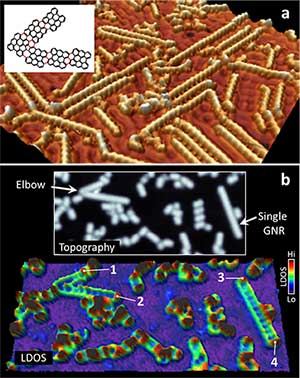Jan 13 2016
Scientists at the Advanced Institute of Materials Research (AIMR) of Tohoku University have effectively used zigzag-edge features to interconnect graphene nanoribbons (GNRs) by means of molecular assembly, and also demonstrated electronic connection between GNRs.
 Fig. 1. (a) Interconnected graphene nanoribbons (GNRs). The interconnection points are observed as elbow structures. The inset of (a) shows the chemical structure of an elbow interconnection point of two chiral-edge GNRs. The top panel of (b) shows the scanning tunneling microscopy topograph, highlighting a single GNR and a pair of connected GNRs (elbow).
Fig. 1. (a) Interconnected graphene nanoribbons (GNRs). The interconnection points are observed as elbow structures. The inset of (a) shows the chemical structure of an elbow interconnection point of two chiral-edge GNRs. The top panel of (b) shows the scanning tunneling microscopy topograph, highlighting a single GNR and a pair of connected GNRs (elbow).
Interconnected end to end, these GNRs form elbow structures, which can be identified as interconnection points.
With this latest configuration, the team were able to show that the electronic architecture at the interconnection points of two GNRs (Fig. 1b) is same of that along a single GNR. This provides evidence that upon chemical GNR interconnection, the electronic properties of the GNRs, such as thermal and electron conductivities, are extended via the elbow structures. The study holds promise for GNR-based electronics that deliver high-performance yet consume minimum power.
It is predicted that graphene will revolutionize electronics. This will happen if the material can be cut into atomically accurate shapes, which is then connected to the desired electrodes. Graphene’s electronic properties (high electron mobility, s pin-aligned zigzag edges, and tailored band gaps) can be controlled currently with bottom-up fabrication techniques, the connection feature of graphene structures has not been directly investigated. For instance, it is not entirely clear as to whether electrons passing over the interconnection points between two GNRs meet higher electric resistance. Relevant answers to these questions can help in developing high-speed, high-performance, and low-power-consumption electronics in the future. In order to resolve this problem, the AIMR team used molecular assembly to address this issue.
Current molecular assemblies either produce straight GNRs (i.e., without identifiable interconnection points), or randomly interconnected GNRs. These growth modes have too many intrinsic unknowns for determining whether electrons travel across graphene interconnection points smoothly. The key is to design a molecular assembly that produces GNRs that are systematically interconnected with clearly distinguishable interconnection points.
Dr. Patrick Han, Project Leader
To reach this goal a Cu substrate was used, its reactivity confines the growth of the GNR to six directions. Scanning tunneling microscopy was used to view the electronic structure of the GNR. With the precursor molecular coverage being controlled, the molecular assembly links the GNRs from various growth directions end-to-end. This resulted in elbow structures, which were later identified as interconnection points (Fig.1a).
With the aid of scanning tunneling microscopy, the researchers were able to show that the delocalization of the interconnected GNR π*-states extends in the same way across one single, straight GNR as well as across the interconnection points between two GNRs. This outcome suggests that the electronic properties of the GNRs must be the same along both single GNRs and two interconnected GNRs.
The major finding of this work is that interconnected GNRs do not show electronic disruption (e.g., electron localization that increases resistance at the interconnection points)," said Han. "The electronically smooth interconnection demonstrates that GNR properties (including tailored band gaps, or even spin-aligned zigzag edges) can be connected to other graphene structures. These results show that finding a way to connect defect-free GNRs to desired electrodes may be the key strategy toward achieving high-performance, low-power-consumption electronics.
Dr. Patrick Han, Project Leader